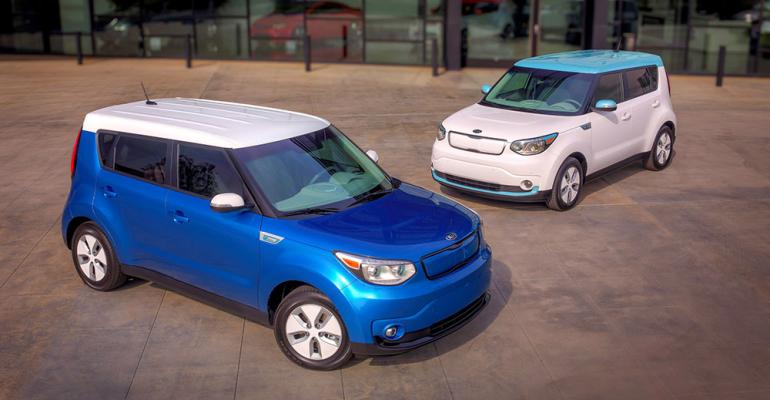CHICAGO – Kia uses its Windy City stage to launch two new eco-friendly models, its first electric vehicle in the U.S. and a refreshed Optima Hybrid.
The ’15 Soul EV, on sale in third-quarter 2014 and based on the second-generation ’14 Soul, marks the first time the brand has offered an all-electric model in the States.
The automaker reiterates many of the details released earlier, however it softens the range, now projected at 80-100 miles (129-161 km) instead of 120 miles (193 km).
Kia announces the car has more than 20 parts, or 10.9 lbs. (4.9 kg), of bio-friendly materials.
“The Soul EV retains the fun and funky style, as well as the packaging efficiency and utility that has made the gasoline-powered Soul such a huge hit with consumers,” Orth Hedrick, vice president-product planning for Kia Motors America, says in a statement. “And to that winning combination it adds useable real-world range and multiple charging options.”
Initially the Soul EV will be sold in the country’s EV hotspots, including California, Oregon, New York, New Jersey and Maryland. Infrastructure and demand for EVs will determine whether sales expand beyond the coasts.
Kia details more specifications of the Soul EV’s battery pack, which it calls a “highly energy-dense lithium-ion polymer” unit.
The 360V, 96-cell, 27-kWh Li-ion pack is air-cooled. A nickel-cobalt-manganese cathode is used for improved capacity and a graphite-based anode is employed for weight reduction and durability reasons, Kia says. Some Li-ions use silicon-based anodes that recharge faster but have fewer recharge cycles.
The Soul EV is powered by a liquid-cooled, AC synchronous permanent magnet, 81.4-kW (109-hp) motor. Multiple layers of magnets not only improve efficiency but lessen motor whine, Kia claims.
The Soul EV has a third-generation regenerative-braking system, which can capture up to 12% of car’s kinetic energy during braking or coasting.
There are four selectable regeneration modes to choose from: Drive or Brakes mode, with Eco mode off or on.
The pack’s location beneath the car’s floor lowers the Soul’s center of gravity and prompts a 5.9% increase in torsional rigidity over the gasoline-engine Soul due to added cross bracing.
The battery’s location cuts rear-seat legroom 3.1 ins. (7.9 cm) and takes 5.1 cu.-ft. (144 L) out of the cargo area due a cooling fan and 120V-charger storage.
A spent Soul EV battery should charge in 24 hours on a 120V outlet or five hours on a 240V outlet.
The car has a single port for 120V/240V charging and another port for 480V “fast charging.” All ports are behind a sliding door on the Soul EV’s front grille.
Kia is offering free charging to Soul EV owners at any of the U.S. dealers selling the car.
The charging ports necessitated a larger grille for the Soul EV compared with conventional models.
Other design tweaks include unique 16-in. alloy wheels with low-rolling resistance tires; LED positioning lamps and taillights; front and rear fascias with color-accented trim; and an “Eco Electric” badge on the fender replacing a “Soul” badge.
Inside, the Soul EV has unique bright-white accent trim on the center console, instrument and door panels.
Some of the bio-based materials include paint on the audio system surround that is free of the petrochemical BTX and cellulose- and sugar cane-derived plastics used in the headliner, carpeting, roof pillars and door panels.
Standard cloth and optional leather seats come in gray with blue stitching or blue piping.
The Soul’s heating, ventilation and air-conditioning system limits power drawn thanks to an available heat pump, which captures surplus heat from the electric system and pipes it into the cabin.
Other power-cutting HVAC technologies include individual ventilation, stopping airflow to the passenger vents; scheduled ventilation, which preheats or precools the cabin while the car is plugged in; and air-induction control, regulating the temperature inside the EV via management of recirculated cabin air.
Also lessening power usage are Kia’s first organic LEDs (OLEDs) in the Soul’s 3.5-in. (8.9-cm) instrument cluster, which details energy flow and charging time, among other EV factoids.
Free for the first five years of ownership is Kia’s UVO EV Services infotainment system, with embedded Verizon cellular service. The system features information specific to EV ownership, such as the ability to search for the nearest public-charging station.
Initially the Soul EV will come in just three color schemes, all with a contrasting roof: white body-blue roof; blue body-white roof; and silver body-white roof.
Pricing for the Soul EV will be announced closer to launch. The standard-powertrain Soul has been one of Kia’s top selling models in the U.S. Sales last year tallied 118,079 units, an increase of 2.0% from 2012, WardsAuto data shows.
Meanwhile, Kia also reveals updates made to the Optima Hybrid.
The car, which debuted in ’11, gets revised front and rear fascias that improve aerodynamics.
The powertrain goes unchanged for ’14, making 199 hp from its 2.4L 4-cyl. gas engine and 47-hp electric motor.
Fuel economy remains 36/40 mpg (6.5-5.9 L/100 km) city/highway for the LX grade and 35/39 mpg (6.7-6.0 L/100 km) city/highway for EX Optima Hybrids.
A third green vehicle also is on Kia’s Chicago stand, the Niro urban hybrid city car from last year’s Frankfurt Auto Show.
The Niro, with 4-wheel-drive, dihedral “butterfly” doors, and a stainless-steel roof, hints at a possible B-segment production car for Kia.





